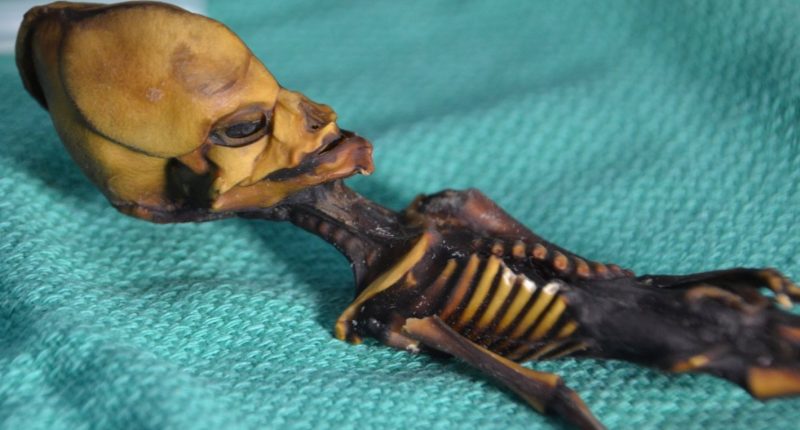A TINY “alien” skeleton found in a desert 20 years ago may actually be a humanoid that lived in a cave in the Middle Ages.
The owner of the remains admitted he had “started to worry” about the creature’s origin due to its alien like features, but he has now been comforted by the discovery.
The mysterious skeleton is only six inches tall and has no knee caps, a pointy cone-shaped skull, slanted eye sockets and ten ribs.
The peculiar remains, dubbed Ata, were discovered in an abandoned church.
Oscar Muñoz found the corpse enclosed inside a leather pouch wrapped in white cloth and tied with a purple ribbon – with nothing to suggest what it was.
Mr Muñoz later sold it to Spanish businessman and researcher Ramón Navia-Osorio Villar.
read more aliens
Mr Navia-Osorio believes the skeleton is from a tiny race of people who used to co-exist with the Aymara people in South America many years ago.
DNA analysis on the skeleton in 2018 suggests it was a human female foetus with unusual mutations linked to dwarfism and scoliosis.
However, a follow-up study by an international research team led by professor of bioarchaeology Siân Halcrow has now disputed the study.
They concluded: “As experts in human anatomy and skeletal development, we find no evidence for any of the skeletal anomalies claimed by the authors.”
Most read in Tech
Since Ata’s discovery, speculation over its origins has run wild with many believing it is extraterrestrial.
The theory grew in popularity after the skeleton featured in a documentary as potential evidence for alien life.
It was found in the Atacama Desert, in Chile in 2003.
However, Mr Navia-Osorio recently appeared on the Spanish TV show Fourth Millennium where he ruled out the possibility of it being alien.
He said: “We received it at the Spanish Royal Academy of Sciences and there we carried out the first X-ray, with low radiation so as not to damage the specimen.
“They already told us that they did not know what it was, the head was so voluminous.
“The hands were so elongated, it had no kneecaps, the clavicle was more triangular than that of humans, I started to worry.”
According to Mr. Navia-Osorio, some of his colleagues categorically stated that Ata was not a human foetus.
He said: “How could it be a foetus if it had calluses on its feet? This creature was not extraterrestrial, it was terrestrial.”
The researcher believes Ata does not come from outer space, but rather coexisted with humans many years ago.
He explained: “They were very small people who lived in caves and only came out at night, hence its strange almond-shaped eyes.
“A native friend from the Aymara tribe told me that these beings used to live with their ancestors before the Spanish settlers arrived.”
The debate surrounding Ata’s origins rages on.
This is not the only strange creature that has had its mystery solved recently.
Read More on The Sun
Last month we told how a bizarre “mermaid” that was thought to be part fish, part monkey and part reptile was actually a hoax.
It was discovered that the creature is completely artificial, made in the late 1800s.












